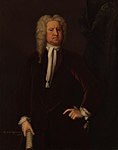
Back গ্রেট ব্রিটেনের সাধারণ নির্বাচন, ১৭৪১ Bengali/Bangla Élections générales britanniques de 1741 French 1741年イギリス総選挙 Japanese 1741년 영국 총선 Korean
| |||||||||||||||||||||||||||||
All 558 seats in the House of Commons 280 seats needed for a majority | |||||||||||||||||||||||||||||
|---|---|---|---|---|---|---|---|---|---|---|---|---|---|---|---|---|---|---|---|---|---|---|---|---|---|---|---|---|---|
| |||||||||||||||||||||||||||||
| |||||||||||||||||||||||||||||
The 1741 British general election returned members to serve in the House of Commons of the 9th Parliament of Great Britain to be summoned, after the merger of the Parliament of England and the Parliament of Scotland in 1707. The election saw support for the government party increase in the quasi-democratic constituencies which were decided by popular vote, but the Whigs lost control of a number of rotten and pocket boroughs, partly as a result of the influence of the Prince of Wales, and were consequently re-elected with the barest of majorities in the Commons, Walpole's supporters only narrowly outnumbering his opponents.
Partly as a result of the election, and also due to the crisis created by naval defeats in the war with Spain, Walpole was finally forced out of office on 11 February 1742, after his government was defeated in a motion of no confidence concerning a supposedly rigged by-election. His supporters were then able to reconcile partially with the Patriot Whigs to form a new government, and the Tories remained excluded from any realistic hope of forming a government.


